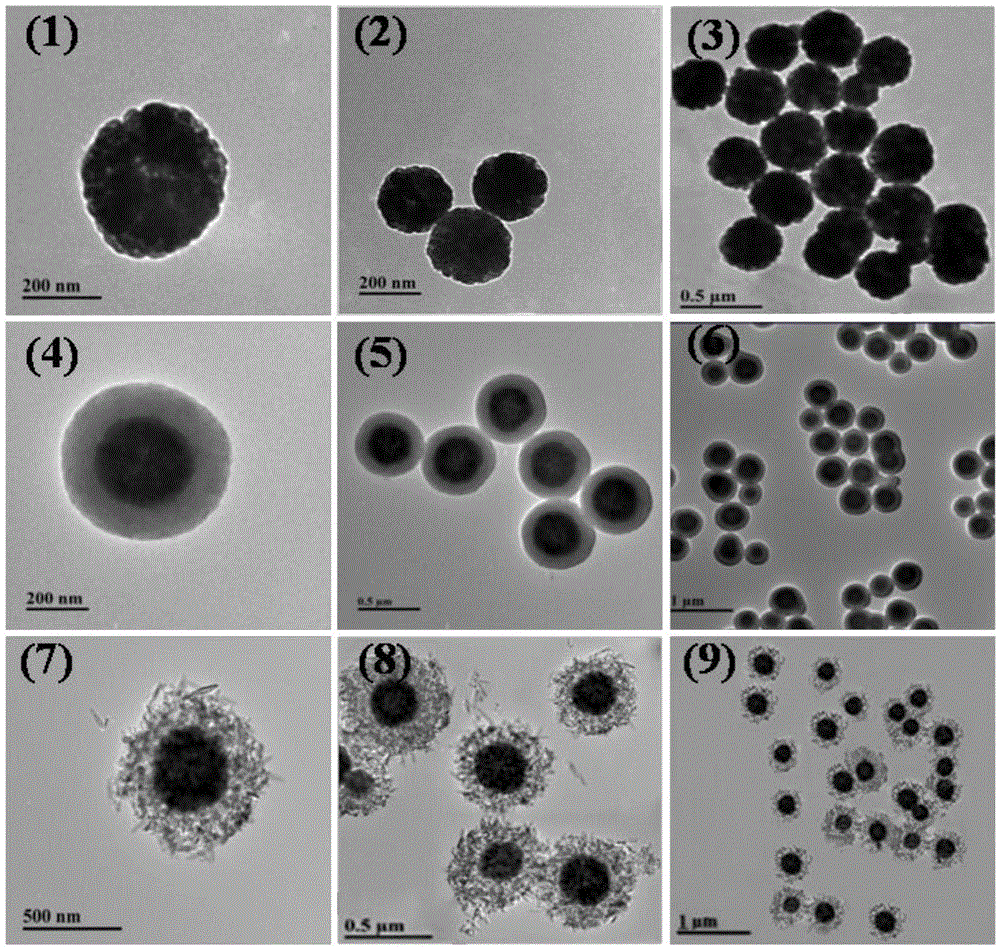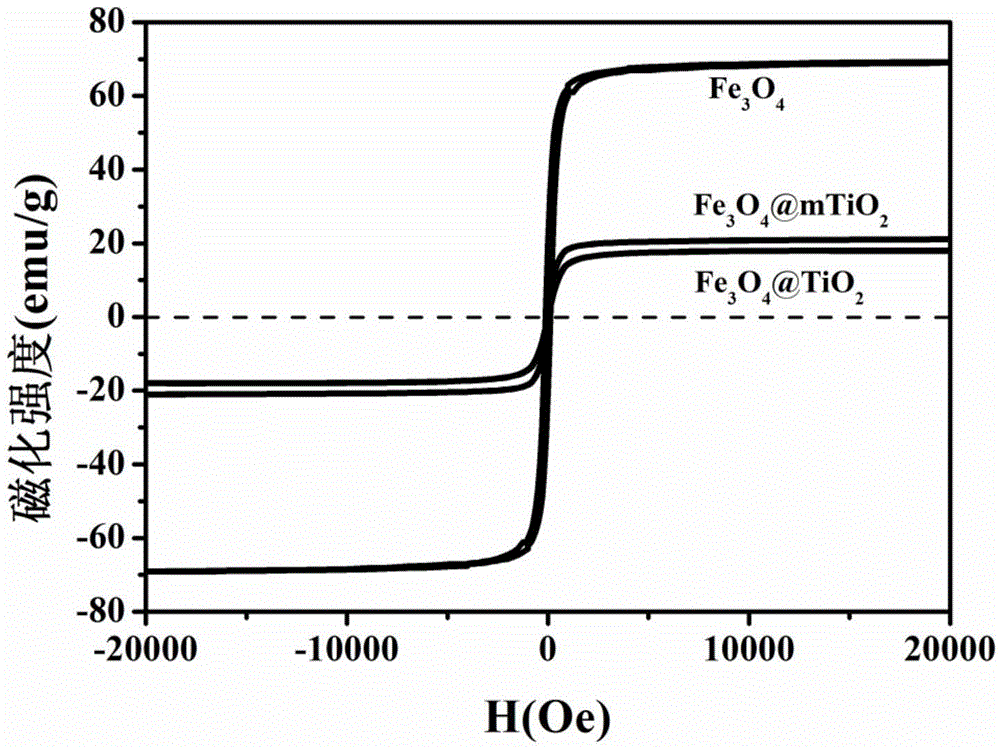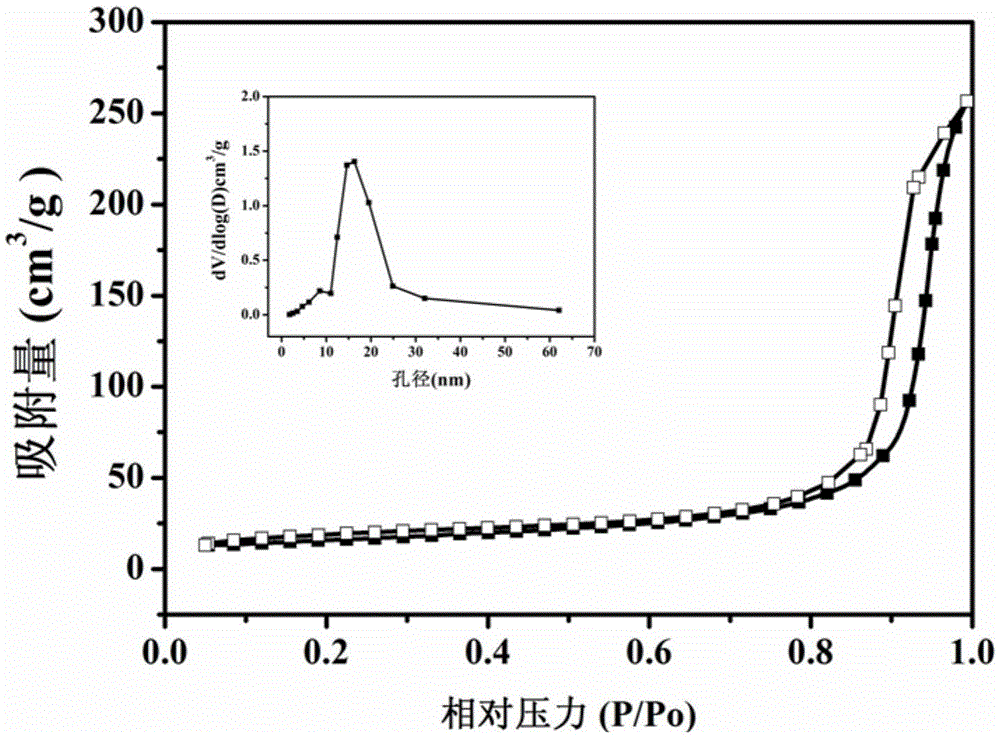Application of Fe3O4/mTiO2 magnetic mesoporous nanometer material in degradation of pesticide
A nanomaterial and mesoporous technology, applied in the field of micro-nano photocatalytic materials, can solve the problems of difficult nano-TiO2 materials, low processing efficiency, separation, etc., and achieve the effects of simple and mature preparation process, high catalytic efficiency and low price.
- Summary
- Abstract
- Description
- Claims
- Application Information
AI Technical Summary
Problems solved by technology
Method used
Image
Examples
Embodiment 1
[0038] Fe 3 o 4 / mTiO 2 Magnetic mesoporous nanomaterials are to the adsorption degradation of omethoate pesticide wastewater (described omethoate, its chemical name is: O, O-dimethyl-S-[2-(methylamino)-2-oxygen On behalf of ethyl] phosphorothioate, the chemical formula is C 5 h 12 NO 4 PS, the CAS number is 1113-02-6)
[0039] (1) Fe 3 o 4 / mTiO 2 Fabrication of Magnetic Mesoporous Nanomaterials:
[0040] ① Mix and dissolve 2.750g of ferric chloride, 9.250g of ammonium acetate and 0.971g of sodium citrate in 150ml of ethylene glycol, and stir vigorously at 170°C for 1 hour to obtain a black solution;
[0041] ②The black solution was sealed and reacted at 200°C for 20h; then cooled, washed 2-3 times with ethanol and deionized water, and dried under vacuum at 60°C to obtain Fe with an average diameter of 280nm 3 o 4 nanospheres;
[0042] ③Add 85mgFe 3 o 4 Nanospheres were dissolved in a mixed solution of 100ml ethanol and 45ml acetonitrile;
[0043] ④Add 0.65ml o...
Embodiment 2
[0057] Example 2: Fe 3 o 4 / mTiO 2 Adsorption and degradation of monocrotophos pesticide wastewater by magnetic mesoporous nanomaterials
[0058] Monocrotophos, its chemical name is: O, O-dimethyl-O-(1-methyl-2 methylcarbamoyl) vinyl phosphate, its chemical formula is C 7 h 14 NO 5 P, CAS number is 6923-22-4.
[0059] Fe 3 o 4 / mTiO 2 The preparation method of magnetic mesoporous nanometer material and this material are used for the absorption degradation test process of monocrotophos pesticide are all the same as embodiment 1, detect through high performance liquid chromatography (HPLC) and total organic carbon analyzer, the result is as follows Figure 5 -B, 6-B, 7-B, the results show that when Fe 3 o 4 / mTiO 2 When the concentration was 100mg / L, after 30min of ultraviolet irradiation, monocrotophos was degraded by 64.38%, and the removal rate of TOC reached 50.3%; when Fe 3 o 4 / mTiO 2 When the concentration was 50mg / L, the degradation rate of monocrotophos wa...
Embodiment 3
[0060] Example 3: Fe 3 o 4 / mTiO 2 Adsorption and degradation of methyl parathion pesticide wastewater by magnetic mesoporous nanomaterials
[0061] Methyl parathion, its chemical name is: O,O-dimethyl-O-(4-nitrophenyl) phosphorothioate, its chemical formula is C 8 h 10 NO 5 PS, the CAS number is 298-00-0.
[0062] Fe 3 o 4 / mTiO 2 The preparation method of the magnetic mesoporous nanomaterial and the adsorption and degradation test process of the material used for methyl parathion pesticide are all the same as in Example 1, and are detected by high performance liquid chromatography (HPLC) and total organic carbon analyzer, the result Such as Figure 5 -C, 6-C, 7-C, the results show that when Fe 3 o 4 / mTiO 2 When the concentration was 100mg / L, after 30min of ultraviolet irradiation, methyl parathion was degraded by 49.74%, and the TOC removal rate reached 39.7%; when Fe 3 o 4 / mTiO 2 When the concentration was 50mg / L, the degradation rate of methyl parathion wa...
PUM
| Property | Measurement | Unit |
|---|---|---|
| wavelength | aaaaa | aaaaa |
| particle diameter | aaaaa | aaaaa |
| pore size | aaaaa | aaaaa |
Abstract
Description
Claims
Application Information
 Login to View More
Login to View More - R&D
- Intellectual Property
- Life Sciences
- Materials
- Tech Scout
- Unparalleled Data Quality
- Higher Quality Content
- 60% Fewer Hallucinations
Browse by: Latest US Patents, China's latest patents, Technical Efficacy Thesaurus, Application Domain, Technology Topic, Popular Technical Reports.
© 2025 PatSnap. All rights reserved.Legal|Privacy policy|Modern Slavery Act Transparency Statement|Sitemap|About US| Contact US: help@patsnap.com



